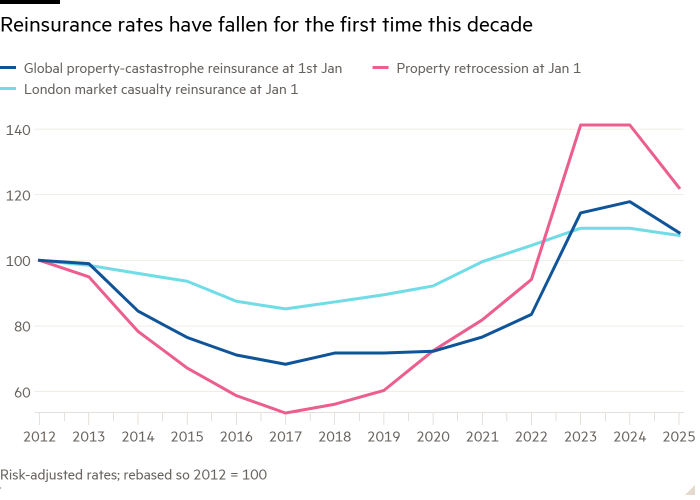Unlock the Editor’s Digest for free
Roula Khalaf, Editor of the FT, selects her favourite stories in this weekly newsletter.
The cost of property catastrophe reinsurance has fallen 8 per cent globally, reflecting reinsurers’ record supply of capital, according to research from Howden, the insurance broker.
The fall in rates on January 1 — the date when policies typically renew — follows two years of bumper profits for providers of reinsurance, which insurers buy to spread natural catastrophe-related losses claimed by homes and businesses. Industry experts have blamed elevated reinsurance costs for contributing to the affordability crisis faced by homeowners.
Rates in the US and Europe fell as much as 15 per cent for insurance accounts that did not suffer losses, Howden said on Thursday.
Dedicated reinsurance capital finished 2024 at a record high of $463bn, up 10 per cent year on year, according to Howden. That was driven by higher asset values and by the growth of catastrophe bonds, which allow institutional investors to take on risks not typically correlated with mainstream assets. The bonds involve insurers or other companies exposed to natural disasters paying investors a coupon to take on some of the risk.
Issuance of “cat bonds” hit a record high of $17.7bn last year, according to Artemis, which tracks the market. Altogether, alternative sources of capital, including cat bonds, account for $116bn of reinsurance capital, or about a quarter of the total; an “extraordinary” share, according to David Flandro, head of industry analysis at Howden’s reinsurance broking arm.
“The net result is that we now have more supply of dedicated capital than we do risk, as measured by premium. That’s why rates have come off a bit,” Flandro said.
None of this meant that risks had abated, Flandro added. Both the peaks and troughs of rates had trended higher, he said, reflecting an overall outlook in which “the world is getting riskier.”
Worldwide insured losses in property catastrophe reached an estimated $136bn in 2024, according to reinsurance broker Guy Carpenter, marking the fifth year running that losses have exceeded $100bn.

But primary insurers are retaining more of those losses, rather than passing them on to reinsurers.
Property reinsurance saw a “big reset” in January 2023, according to David Duffy, head of global clients at Guy Carpenter, when prices jumped and reinsurers renegotiated terms and conditions, trimming the amount of risk they were willing to absorb.
As a result, reinsurers have been less exposed to smaller perils — such as severe thunderstorms or tornadoes, which do not do as much damage individually as a big hurricane or earthquake — but where the combined impact is contributing to rising losses for primary insurers.
Meanwhile, even as prices for reinsurance have softened globally, regions with heavy losses as a result of extreme weather faced price increases for some types of reinsurance coverage of as much as 30 per cent, Guy Carpenter found. Canada had experienced its worst year for insured losses in recorded history, Duffy said, with two major floods, a wildfire, and a severe convective storm.











